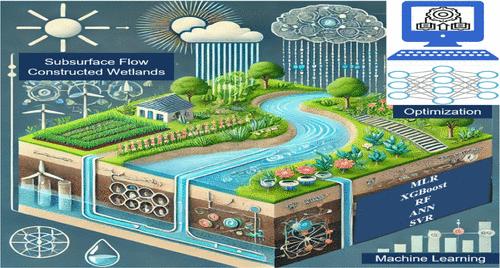A Futuristic Approach to Subsurface-Constructed Wetland Design for the South-East Asian Region Using Machine Learning
引用次数: 0
Abstract
This study investigates the optimized design of horizontal flow constructed wetlands (HFCWs) to enhance pollutant removal efficiency while minimizing surface area requirements, particularly in the Southeast Asian region. By refining the first-order removal rate coefficient (k) for organics and nutrients, the research aims to meet specific performance benchmarks across three scenarios, ensuring compliance with discharge or reuse standards. Utilizing a data set comprising 1680 entries, five machine learning models─multiple linear regression (MLR), eXtreme Gradient Boosting (XGBoost), random forest (RF), artificial neural network (ANN), and support vector regression (SVR)─were employed to predict k values. Pearson’s correlation, heat maps, and ANOVA analysis identified the most influential parameters affecting k-value predictions. The k values ranged from 0.01 to 0.52 per day using the P–k–C* method, essential for effective pollutant removal. The SVR model demonstrated the highest predictive accuracy, with R2 values of 0.91 for kBOD, 0.90 for kTN, 0.82 for kTKN, and 0.76 for kTP. This optimization reduced standard deviations significantly, from 136.90% to 2.28%. Consequently, the required wetland area was reduced by up to 68% for biochemical oxygen demand (BOD), 60% for TN (total nitrogen), and 67% for TP (total phosphorus) in larger systems, supporting the tailored design of HFCWs to meet targeted discharge standards.

利用机器学习为东南亚地区设计地下湿地的未来方法
本研究调查了水平流人工湿地 (HFCW) 的优化设计,以提高污染物去除效率,同时最大限度地减少表面积要求,尤其是在东南亚地区。通过改进有机物和营养物的一阶去除率系数 (k),该研究旨在满足三种情况下的特定性能基准,确保符合排放或再利用标准。利用由 1680 个条目组成的数据集,采用了五种机器学习模型 - 多元线性回归 (MLR)、极梯度提升 (XGBoost)、随机森林 (RF)、人工神经网络 (ANN) 和支持向量回归 (SVR) - 来预测 k 值。皮尔逊相关性、热图和方差分析确定了对 k 值预测影响最大的参数。使用 P-k-C* 方法得出的 k 值范围为每天 0.01 到 0.52,这对有效去除污染物至关重要。SVR 模型的预测精度最高,kBOD 的 R2 值为 0.91,kTN 为 0.90,kTKN 为 0.82,kTP 为 0.76。这一优化大大降低了标准偏差,从 136.90% 降至 2.28%。因此,在较大的系统中,生化需氧量(BOD)、总氮(TN)和总磷(TP)所需的湿地面积分别减少了 68%、60% 和 67%,从而支持了 HFCWs 的定制设计,以达到目标排放标准。
本文章由计算机程序翻译,如有差异,请以英文原文为准。
求助全文
约1分钟内获得全文
求助全文

 求助内容:
求助内容: 应助结果提醒方式:
应助结果提醒方式:


